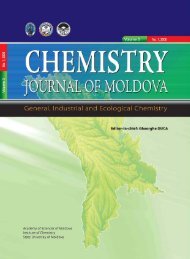2011, nr. 1 - Academia de Ştiinţe a Moldovei
2011, nr. 1 - Academia de Ştiinţe a Moldovei
2011, nr. 1 - Academia de Ştiinţe a Moldovei
You also want an ePaper? Increase the reach of your titles
YUMPU automatically turns print PDFs into web optimized ePapers that Google loves.
<strong>Ştiinţe</strong> Medicale<br />
ample ce permit stabilirea corectă și diferenţiată a diagnosticului.<br />
Stabilirea și confi rmarea diagnosticului<br />
corect permit anularea medicamentelor antiepileptice<br />
inutile și alegerea unui tratament a<strong>de</strong>cvat [2]. TVE-<br />
EG este standardul <strong>de</strong> aur pentru diferenţierea evenimentelor<br />
epileptice și non-epileptice. Mohan et al.<br />
[7] a făcut o analiză retrospectivă datele privind 444<br />
<strong>de</strong> pacienţi care au fost invesigaţi prin TVEEG în scopuri<br />
diagnostice (cu excepţia celor care au fost admiși<br />
la studiu prechirurgical) și a raportat că la 73% pacienţi<br />
s-a reușit obţinerea informaţiei utile. Într-un alt<br />
studiu care a inclus 400 <strong>de</strong> pacienţi investigaţi prin<br />
TVEEG s-a stabilit că metoda oferă informaţii <strong>de</strong> diagnostic<br />
unui număr <strong>de</strong> 289 <strong>de</strong> pacienţi (72%), din care<br />
31 <strong>de</strong> pacienţi (11%) au avut crize psihogene [1].<br />
Analiza traseului EEG în lotul <strong>de</strong> pacienţi din<br />
studiul dat a relevat modifi cări patognomice tip epileptic<br />
la 504 pacienţi (69,8% din 722 <strong>de</strong> pacienţi). În<br />
acest fel, au fost obţinute informaţii <strong>de</strong> diagnostic,<br />
comparabile cu studiul lui Mohan et al. [7]. Diagnosticul<br />
<strong>de</strong> epilepsie a fost stabilit la 72 <strong>de</strong> pacienţi, la<br />
care s-au î<strong>nr</strong>egistrat evenimente clinice. Evenimente<br />
non-epileptice s-au î<strong>nr</strong>egistrat la alţi 9 pacienţi, ceea<br />
ce constituie 11% din totalul evenimentelor. Ele sunt<br />
comparabile cu datele lui Boon [1], dar sunt mai mici<br />
<strong>de</strong>cât în studiul lui Mohan [7]. Analiza raportului prezenţei<br />
crizelor epileptice parţiale și celor generalizate<br />
a evi<strong>de</strong>nţiat un raport <strong>de</strong> 58% versus 42%. Datele obţinute<br />
corespund cu cele prezentate <strong>de</strong> Shorvon et al.<br />
[11], care a apreciat acest raport în variaţiile 33-65%<br />
pentru crizele epileptice parţiale și 17-60% pentru crizele<br />
epileptice generalizate.<br />
Astfel, rezultatele obţinute ne permit să subliniem<br />
rolul diagnostic înalt al meto<strong>de</strong>i TVEEG. Examenul<br />
<strong>de</strong> monitorizare <strong>de</strong> lungă durată permite evi<strong>de</strong>nţierea<br />
particularităţilor <strong>de</strong> activitate cerebrală, activitate<br />
epileptiformă și prezenţa fenomenelor clinice, care<br />
asigură stabilirea unui diagnostic corect și administrarea<br />
tratamentului a<strong>de</strong>cvat.<br />
Bibliografi e<br />
1. Boon P, Michielsen G, Goossens L, et al. Interictal<br />
and ictal vi<strong>de</strong>o-EEG monitoring. Acta Neurol. Belg. 1999;<br />
99:247–255.<br />
2. Cascino G.D. Clinical indications and diagnostic<br />
yield of vi<strong>de</strong>o-electroencephalographic monitoring in patients<br />
with seizures and spells. Mayo Clin Proc. 2002; 77:1111-<br />
1120.<br />
3. Cascino G.D. Vi<strong>de</strong>o-EEG monitoring in adults.<br />
Epilepsia 2002; 43 Suppl 3:80-93.<br />
4. Klem G. H., Lü<strong>de</strong>rs H.O., Jasper HH, Elger C. Th e<br />
ten-twenty electro<strong>de</strong> system of the International Fe<strong>de</strong>ration.<br />
Th e International Fe<strong>de</strong>ration of Clinical Neurophysiology.<br />
Electroencephalogr Clin Neurophysiol Suppl. 1999; 52:3-6.<br />
67<br />
5. Kwan P., Brodie M.J. Early i<strong>de</strong>ntifi cation of refractory<br />
epilepsy. N. Engl. J. Med., 2000; 342:314-319.<br />
6. Lee Y.Y., Lee M.Y., Chen I., Tsai Y.T., Sung C.Y.,<br />
Hsieh H.Y., Lim S.N., Hung P.W., Wu T. Long-term Vi<strong>de</strong>o-<br />
EEG Monitoring for paroxysmal events. Chang. Gung. Med.<br />
J., 2009; 32:305-312.<br />
7. Mohan K.K., Markand O.N., Salanova V. Diagnostic<br />
utility of vi<strong>de</strong>o EEG monitoring in paroxysmal events.<br />
Acta Neurol. Scand., 1996; 94:320–325.<br />
8. Nuwer M.R., Comi G., Emerson R., Fuglsang-Fre<strong>de</strong>riksen<br />
A., Guérit J.M., Hi<strong>nr</strong>ichs H., Ikeda A., Luccas F.J.,<br />
Rappelsberger P. IFCN standards for digital recording of clinical<br />
EEG. Th e International Fe<strong>de</strong>ration of Clinical Neurophysiology.<br />
Electroencephalogr Clin Neurophysiol Suppl.<br />
1999; 52:11-14.<br />
9. Panayiotopoulos C. P., Koutroumanidis M., Th e<br />
signifi cance of the syndromic diagnosis of the epilepsies, National<br />
Society for Epilepsy, 2005.<br />
10. Porter R.J., Pe<strong>nr</strong>y J.K., Lacy J.R. Diagnostic and<br />
therapeutic reevaluation of patients with intractable epilepsy.<br />
Neurology 1977; 27:1006-1011.<br />
11. Shorvon S., Perucca E., Fish D., Dodson E. Th e<br />
treatment of epilepsy. Blackwell Publishing, 2004; 913:923.<br />
Rezumat<br />
Este cunoscut faptul că aproape două treimi din pacienţii<br />
cu epilepsie pot fi trataţi efi cient, tratamentul fi ind<br />
indicat în conformitate cu un diagnostic corect. Una dintre<br />
cele mai informative meto<strong>de</strong> <strong>de</strong> diagnostic este telemetria<br />
vi<strong>de</strong>o-EEG (TVEEG). Prezenta comunicare evi<strong>de</strong>nţiază tipurile<br />
<strong>de</strong> crize epileptice și rolul examenului (TVEEG) în<br />
stabilirea și specifi carea diagnosticului <strong>de</strong> epilepsie.<br />
Резюме<br />
Известно, что почти две трети пациентов<br />
с эпилепсией могут быть вылеченными при<br />
правильной терапии которая может быть назначена<br />
после постановки правильного диагноза. Одним из<br />
наиболее информативных инструментальных методов<br />
диагностики является видео-ЭЭГ телеметрия. В<br />
публикации рассматриваютсятся типы эпилептических<br />
приступов и роль видео-ЭЭГ телеметрии в постановке<br />
и уточнении диагноза эпилепсии.<br />
Summary<br />
It is known than nearly two thirds of epileptic patients<br />
can be cured by proper therapy which can be prescribed<br />
aft er establishing of correct diagnosis. One of the most<br />
informative instrumental diagnostic techniques is vi<strong>de</strong>o-<br />
EEG telemetry. Th is communication <strong>de</strong>scribes the types<br />
of epileptic seizures and the role of telemetric vi<strong>de</strong>o-EEG<br />
examination in establishing and specifying the diagnosis of<br />
epilepsy.

















